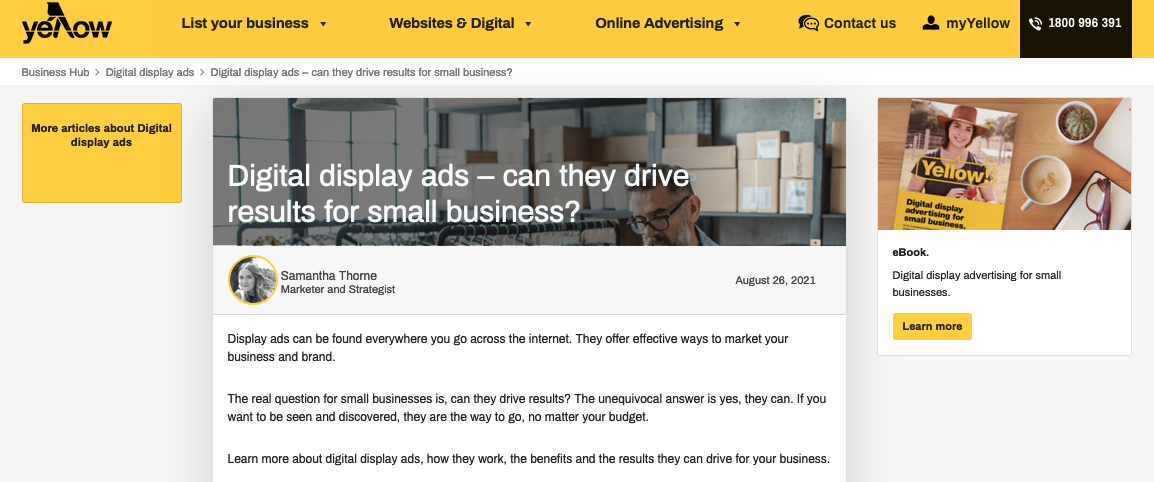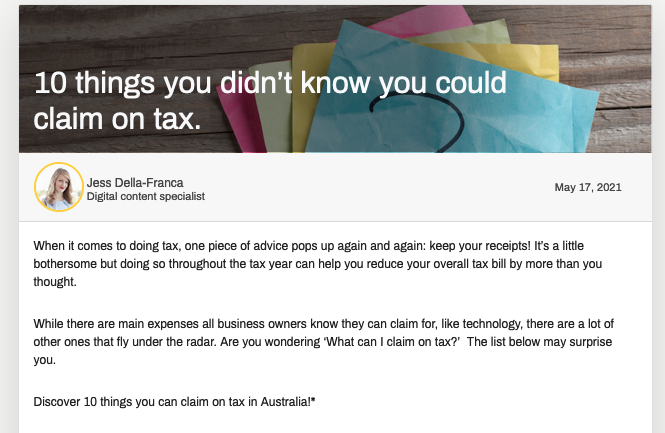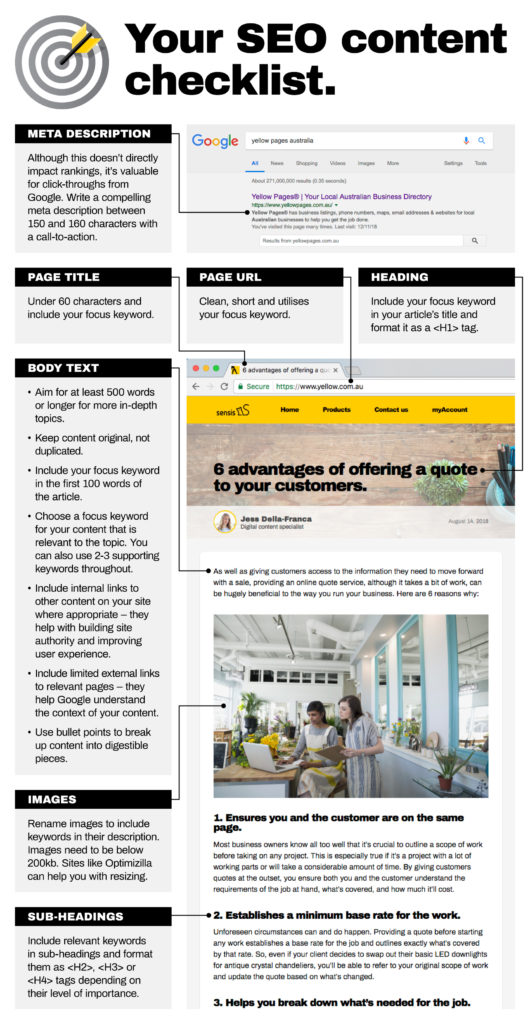Content marketing and SEO are like bread and butter, or cheese and wine. Although they’re technically two separate things, they belong together. To be successful in SEO, you need to have great content.
So how do the two work together to improve your ranking in Google search?
The importance of content for SEO.
Before jumping straight to the creation of content in SEO, it’s essential to understand what SEO is and how it works.
SEO stands for search engine optimisation, and it determines where your website appears when someone does a Google search. It’s important because websites on the first page of results have a monopoly over traffic: at least 75% of all clicks go to first page results. Additionally, the closer to the top of the page you are, the more likely you are to receive a click, with 43.32% going to position one results, and just 3.11% going to position ten results.
And assuming your website is well designed and filled with great content, those extra click-throughs should mean more engagement, inquiries and sales.
While there are currently 200+ factors that determine where your website lands in search, Google itself says high-quality content and backlinks are the most important.
RELATED: What is backlinking and why does your site need it?
So how exactly does SEO work with your content marketing strategy? SEO expert Neil Patel says it best: “SEO states the requirements. Content marketing fulfills them.” In this case, keywords are major requirements, and your content—be it web pages, blog or social media posts — is a big part of the answer.
Let’s take a closer look at how the two go hand-in-hand.
Keywords help your content get discovered by users.
SEO is based on search phrases, because any time someone searches for something in Google, they are entering certain keywords, phrases, or questions they want information about. That’s why your content needs to seek to mirror those same keywords – it’s how Google will know your content is a good ‘answer’ for the searcher’s ‘question’.
Regardless of whether it’s a blog post, an FAQ section, or your About Us page, keywords need to be included naturally in your content to help Google list it in search results. This includes your site’s title tag and meta description.
Here’s an example of SEO copywriting:

In this case, ‘digital display ads’ is the keyword that users are entering into their search bar. The heading incorporates this keyword in a natural way, and it’s also included in the meta description which has been optimised for Google search results.
Content helps increase backlinks.
As mentioned earlier, backlinks are crucial for your Google ranking. When more websites link to your page, Google sees it as an authoritative source and pushes it up in search rankings.
Additionally, the more authoritative the linking website, the more it is worth for your website. In other words, if an internationally renowned website such as Forbes were to link to your website, you would get more ‘SEO juice’ from it than you would if your friend’s personal blog with a dozen readers linked to your site (although the latter is still better than nothing).
One of the best ways to get backlinks is to create awesome content on your website that other websites or social media users want to link back to organically. For example, if you’re a plumber and you (or your content marketing agency) create a blog post on ’10 plumbing problems that require expert help’, other websites or customers might find it helpful and share your post, or repost it on their site with a link back to yours.
RELATED: SEO boosting backlinks and how to get them for free.
New content keeps it fresh.
Google loves new, relevant content. By posting timely content, you improve your chances of getting ranked quickly by Google and appearing above your competitors.
Take a look at this SEO campaign Yellow Pages ran in May 2021. In addition to regular website content, we created a series of blog posts to offer relevant content for those searching for information about the end of the financial year.

3 quick tips to integrate your content and SEO strategy.
- Do your keyword research. Without keywords, you’re shooting in the dark. Tools like Ubersuggest can help you with keyword suggestions.
- Optimise content writing for SEO keywords. This includes all of your landing pages (such as your About Us page), product pages, and blog or article section.
- Use a content marketing planner to schedule timely content. Yellow Pages’ Calendar of Events is a great place to start to keep an eye on upcoming events.

What makes great content?
Whether you’re writing a landing page, a sales email, a blog or something else entirely, there are certain things you should do to make sure the content will resonate with readers.
Here are some things keep in mind:
Well-written, edited copy.
Readers today are bombarded with options for content. They will only stick around to read something if it’s well-written—this means it doesn’t contain major errors; it’s written in plain English; and it uses a tone that is unique and engaging.
Make sure you have at least one person on your team, aside from your writer, who is in charge of editing the content. Even the best writers make mistakes and a fresh pair of eyes can make a huge difference!
Formatted for the reader.
Have you ever opened a blog article to find an impenetrable wall of text? Too many long paragraphs with no breaks is a big turn-off for readers. Break up the content with images, graphics, videos and, most importantly, sub-headers so it’s easy to digest.
Plagiarism-free and up-to-date.
Readers are only interested in content that is unique, well-researched and up-to-date. Take time to update your most popular articles every few months to make sure they contain recent information.
SEO-driven content.
Search engine optimisation (SEO) and content marketing go hand-in-hand. There are a lot of moving parts when it comes to SEO, so here’s a good starting point if you’re new to the subject.
SEO is an enormous topic but, if you’re aiming for success with this method, high-quality content is the key. If you’re consistently creating high quality content that solves problems for your readers, you’re already likely doing some of the things that are important for strong SEO.
Beyond healthy and frequent content creation, here are some of the other most important elements of SEO to keep in mind:
- Keywords implemented throughout your content
- Meta data (descriptions and alt tags on images) filled out with unique copy
- High-quality content creation (landing pages, blogs, thought leadership, etc.)
- Backlinks (links pointing from strong websites to your own website)
- Internal linking (links leading from one page to another on your own website).

The best types of content for generating traffic.
With so many different types of content out there, it’s hard to know which ones will do the best job bringing traffic to your website.
A healthy content marketing strategy involves a diverse range of content, so don’t pick just one option from this list. Instead, think about your goals and choose the content types that work best for what you’re trying to do.
Long-form blogs.
If you’re striving for SEO, it’s hard to beat long-form blog articles. These content pieces, usually at least 1,000 words, give readers a deep dive on a particular topic that’s both important to them and relevant to your product and services.
For example, if you run a financial planning service, you might write a long-form article about how people can improve their credit score. A dog groomer might write an article about the best ways to care for your pooch’s coat between groomings.
In both of these scenarios, there would be opportunities to put in calls-to-action that are both relevant and likely to drive traffic.
The financial planner could provide a link to her consulting services for people who are improving their credit score and want more help. The groomer could put in a number of reminders about booking in grooming appointments.
How-to articles.
When picking up a new skill or attempting to complete a task, people turn to the internet for answers. And you can be there to answer their queries if you write strong how-to content.
These types of content pieces come in many forms—you might create a how-to video for one of your products/services or a text-driven walk-through on how to do something related to your industry. Either way, focus on making it clear and easy for the reader.
Video content.
According to Cisco, by 2022, videos will make up more than 82% of all consumer internet traffic.
People love watching videos, whether it’s a product unboxing, a how-to guide (see above), or something fun and simple. When creating video content on your site, it’s a good idea to include a transcript or blog article with it.
This is useful for two reasons: first, it appeals to members of your audience who prefer reading over video. Secondly, Google’s search engine algorithm understands text but it can’t comprehend video as well.
Giving a text write-up of the video on the same page makes it easier for search engines to understand what the video is all about. In other words, video transcripts are good for SEO and user experience.
Graphic content.
Humans are visual by nature, so creating visual content is a good move. Thirty-two percent of marketers advocate for visuals as being the most important form of content for their business.
Infographics are the most common type of visual content, but you can also look into creating things like a photo series, mini graphics showing quotes or quick tips, or well-designed eBooks.
Templates, checklists and guides.
Downloadable content serves two purposes for small businesses—the content itself can generate traffic and offering a free giveaway of something useful encourages people to sign up to your mailing list. Why not kill two birds with one stone?
When coming up with a downloadable template, think about what problem your customers might be facing. For example, if you run a home renovation business, your audience might have trouble figuring out what to do before they start their renovation.
Why not provide them with a downloadable checklist titled ‘Your Home Renovation Prep Checklist’. This asset could be offered to any of your new clients but also advertised on your website and social media pages to drive more traffic to your site.
Download your free ‘Checklist template’ here.
Interviews with influencers.
Generating traffic via your content is a lot easier with the help of an influencer—and we aren’t necessarily talking about Instagram models.
Interviews with experts in your industry, happy customers or interesting people who have a decent online following can make your website traffic grow exponentially.
Interactive content.
If you really want to drive traffic to your site, consider putting together a piece of interactive content.
Things like quizzes and clickable infographics can drive a lot of engagement and are great for sharing, which boosts your social media marketing strategy.

How to promote your content.
You can create the most compelling, well-designed content but, without a promotion strategy, it won’t have much of an impact. How you promote your content is up to you (and your budget) but here are a few of the best methods for getting more eyes on your work.
Social media.
By far, social media is the best place to promote your content. Facebook, Twitter, Instagram, LinkedIn, and Pinterest all offer an avenue for organic traffic growth, or you can put some budget behind advertising on these platforms and see your numbers grow even faster.
Third-party promotion.
Sometimes you can use the power of another website to drive traffic to your own. Try getting some content published on another site by creating a guest post or collaborating with others in your industry.
Look for businesses that aren’t a direct competitor but share a similar audience and reach out to see if they’d be open to collaboration.
Your SEO content checklist.
There are loads of SEO blogs and SEO checkers out there with all sorts of advice and recommendations, but the truth is that Google simply wants your content to be easy to read by its algorithm and by humans.
If you can create content that’s fresh, valuable, and relevant to your audience, half the SEO battle is won right then and there. Instead of trying to stuff keywords in as many places as possible, think of them as a tool to find out what sort of things people are searching for, form ideas based on those searches and help give your content context.
Take a look at our SEO content checklist below to help keep you on the right track. To download the checklist, click on the image.
How digital marketing from Yellow Pages helps your business grow online.
The team at Yellow Pages provides expert digital marketing advice and products that boost your business’ online presence. From an online listing to digital display or social media ads, we’ll tailor a digital marketing strategy designed for your business. Find out more.

